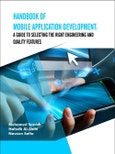Readers will also learn about how to optimize the listed features to tailor their applications to the needs of their users.
Key Features:
- Presents detailed information about eight different features which guide mobile application development: capability, reliability, usability, charisma, security, performance, mobility and compatibility
- Reader-friendly, structured layout of each chapter including relevant illustrations and clear language, designed for quick learning
- Focus on both software function and user perception of applications on mobile devices
- Includes a handy appendix with information about mobile learning projects and related work packages
Handbook of Mobile Application Development: A Guide to Selecting the Right Engineering and Quality Features is the ideal learning tool for novice software developers, computer science students, IT enthusiasts and marketers who want to design or develop mobile apps for an optimal user experience.
Table of Contents
Chapter 1 Capability: Can Mobile Application Perform Valuable Functions?1. Introduction
2. Capability
3. Completeness
4. Accuracy
5. Efficiency
6. Interoperability
7. Concurrency
8. Data Agnosticism
9. Extensibility
- Summary
- References
Chapter 2 Reliability: Can a Mobile Application be Trusted in Many And
- Difficult Situations?
2. Reliability
3. Stability
4. Robustness
5. Recoverability
6. Data Integrity
7. Trustworthiness
- Summary
- References
Chapter 3 Usability: Can Mobile Applications be Used Easily?
1. Introduction
2. Usability
3. Intuitiveness
4. Minimalism
5. Learnability
6. Memorability
7. Discoverability
8. Operability
9. Interactivity
10. Control
11. Clarity
12. Errors
13. Consistency
14. Accessibility
15. Documentation
- Summary
- References
Chapter 4 Charisma: Do Mobile Applications Have Charisma?
1. Introduction
2. Charisma
3. Uniqueness
4. Satisfaction
5. Professionalism
6. Attractiveness
7. Curiosity
8. Entrancement
9. Hype
10. Expectancy
11. Attitude
12. Impression
13. Story
- Summary
- References
Chapter 5 Security: Does Mobile Application Protect Against
- Unwanted Usage?
2. Security
3. Authentication
4. Authorization
5. Privacy
6. Security Holes
7. Secrecy
- Summary
- References
Chapter 6 Performance: is the Mobile Application Fast Enough?
1. Introduction
2. Performance
3. Capacity
4. Resource Utilization
5. Responsiveness
6. Availability
7. Throughput
8. Endurance
9. Feedback
10. Scalability
- Summary
- References
Chapter 7 Mobility: is the Application Easy to Install, Maintain And Support?
1. Introduction
2. Mobi-Bility
3. Application Requirements
4. Install-Ability
5. Upgradability
6. Uninstallation
7. Configuration
8. Deployability
9. Maintainability
10. Testability
- Summary
- References
Chapter 8 Compatibility: How Does Mobile Application Interacts With Environments?
1. Introduction
2. Compatibility
3. Device Compatibility
4. Operating System Compatibility
5. Application Compatibility
6. Configuration Compatibility
7. Backward Compatibility
8. Forward Compatibility
9. Sustainability
10. Standards Conformance
- Summary
- References
- Appendix
- Mobile Learning Research Project
- Research Objectives and Aims
- Scope of the Project
- Research Methodology
- Work Package 1: Research Background
- Work Package 2: Advanced Nations M-Learning Experiences
- Work Package 3: Case Study
- Work Package 4: Data Analysis
- Work Package 5: Framework
- Work Package 6: Prototype Implementation
- Work Package 7: Evaluation
- Work Package 8: Project Documentation
- Project Findings
- Limitation and Implications for Future Studies
- Recommendations
- Future Concerns and Challenges
- Subject Index
Author
- Mohamed Sarrab
- Hafedh Al-Shihi
- Naveen Safia








